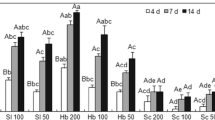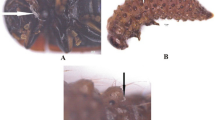Abstract
The sugar beet weevil, Bothynoderes punctiventris Germ. (Coleoptera: Curculionidae), is one of the most damaging pests of sugar beets in Turkey and has been traditionally controlled by application of large amounts of insecticides. The current study used laboratory microcosms to evaluate the possibility of using entomopathogenic nematodes as an alternative control method. The nematodes Steinernema feltiae (strain TUR-S3), Steinernema weiseri (BEY) and Heterorhabditis bacteriophora (TUR-H2) had previously been isolated from Turkey. Nematode-induced mortality generally increased as soil temperature increased from 15 to 25°C but decreased when larvae were located deeper in soil. Heterorhabditis bacteriophora caused the highest larval mortality at 25°C at all depths (5–20 cm). Steinernema feltiae and S. weiseri were more effective than H. bacteriophora at 15°C at all depths. Increasing the application rate of infective nematode dauer juveniles (DJs) affected the number of DJs that penetrated each insect larva and the number of DJs produced per insect. The highest production of DJs per larva occurred at application rates of 50 DJs/larva for S. feltiae and S. weiseri and 100 DJs/larva for H. bacteriophora. Reproduction decreased again at higher application rates. Heterorhabditis bacteriophora had the highest reproductive capability. The results indicate that S. feltiae and S. weiseri might be more effective against this pest early in the growing season when soil temperature is low and that H. bacteriophora might be more effective later in the season when temperature increases.
Similar content being viewed by others
References
Abbott WS (1925) A method for computing the effectiveness of an insecticide. J Econ Entomol 18:265–267
Bélair G, Wright DJ, Curto G (2005) Vegetable and tuber crop applications. In: Grewal PS, Ehlers R-U, Shapiro-Ilan DI (eds) Nematodes as biological control agents. CABI Publishing, Wallingford, pp 255–264
Boff MIC, Wiegers GL, Gerritsen LJMP, Smits H (2000) Development of the entomopathogenic nematode Heterorhabditis megidis strain NLH-E87.3 in Galleria mellonella. Nematology 2:303–308
Boselli M, Curto GM, Tacconi R (1997) Field Efficacy of entomopathogenic nematodes against the sugar-beet weevil Temnorhinus (= Conorrhynchus) mendicus Gyll. (Coleoptera: Curculionidae). Biocontrol Sci Technol 7:231–238
Burman M (1982) Neoplectana carpocapsae: a toxin production by axenic insect parasitic nematodes. Nematology 28:62–70
Campbell JF, Gaugler R (1993) Nictation behaviour and its ecological implications in host search strategies of entomopathogenic nematodes. Behaviour 126:155–169
Ciche TA, Darby C, Ehlers R-U, Forst S, Goodrich-Blair H (2006) Dangerous liaisons: the symbiosis of entomopathogenic nematodes and bacteria. Biol Control 38:22–46
Csontos AS (2002) Lateral movement of the entomopathogenic nematodes Steinernema glaseri and Heterorhabditis bacteriophora in sand at different temperatures in response to host seeking. Biocontrol Sci Technol 12:137–139
Dowds BCA, Peters A (2002) Virulence mechanisms. In: Gaugler R (ed) Entomopathogenic nematology. CABI Publishing, Wallingford, pp 79–98
Ehlers R-U (2001) Mass production of entomopathogenic nematodes for plant protection. Appl Microbiol Biotechnol 56:623–633
Grewal PS, Selvan S, Gaugler R (1994) Thermal adaptation of entomopathogenic nematodes: niche breath for infection, establishment, and reproduction. J Therm Biol 19:245–253
Griffin CT (1993) Temperature responses of entomopathogenic nematodes for the success of biological control programs. In: Bedding R, Akhurst R, Kaya H (eds) Nematodes and biological control of insect pests. CSIRO Publications, Collingwood, pp 101–111
Hazir S, Stock SP, Kaya HK, Koppenhöfer AM, Keskin N (2001) Developmental temperature effects on five geographic isolates of the entomopathogenic nematode Steinernema feltiae (Nematoda: Steinernematidae). J Inverteb Pathol 77:243–250
Hoffmann A (1966) Sous-famille des Cleoninae. In: Balachowsky AS (ed) Entomologie Appliquée à l’Agriculture 1, Masson et Cie. Éditeurs, Paris, pp 953–981
Kaya HK, Stock SP (1997) Techniques in ınsect nematology. In: Lacey LA (ed) Manual of techniques in ınsect pathology. Academic Press, New York, pp 281–324
Manninger GA (1990) Sugar-beet weevil (Cleonus Punctiventris Germar). In: Jermy T, Balázs K (eds) A Növényvédelmi Állattan Kézikönyve III/A Akadémiai Kiadó. Budapest, Hungary, pp 471–476 (in Hungarian)
Özgör OE (2005) Kaliteli seker pancari yetistirilmesi. Amasya seker fabrikasi press, Suluova
Parkman JP, Smart GC (1996) Entomopathogenic nematodes, a case study: ıntroduction of Steinernema scapterisci in Florida. Biocontrol Sci Technol 6:413–420
Poinar GO (1990) Biology and taxonomy of Steinernematidae and Heterorhabditidae. In: Gaugler R, Kaya HK (eds) Entomopathogenic nematodes in biological control. CRC Press, Boca Raton, pp 23–58
Sekulic R, Keresi T, Strbac P, Radin Z (1997) The beet weevil (Bothynoderes punctiventris Germ.)—the most dangerous spring pest of sugar beet. Biljni Lek 2:164–173 (in Serbian)
Selvan S, Campbell F, Gaugler R (1993) Density-dependent effects on entomopathogenic nematodes (Heterorhabditidae and Steinernematidae) within an insect host. J Invertebr Pathol 62:278–284
Statistica (1991) Complete statistical system by StatSoft Inc., 2325 East 13th Street, Tulsa, OK 74104
Susurluk A (2006a) Effectiveness of the entomopathogenic nematodes, Heterorhabditis bacteriophora and Steinernema feltiae against Tenebrio molitor (yellow mealworm) larvae at different temperature and soil types. Turk J Biol 30:199–205
Susurluk IA (2006b) Comparison of some biological characterizations of the entomopathogenic nematodes, Steinernema weiseri and S. feltiae (Rhabditida: Steinernematidae), ısolated in Turkey. Turk J Agri Sci 12:340–344
Susurluk IA (2008) Influence of temperature on the vertical movement of the entomopathogenic nematodes, Steinernema feltiae (TUR-S3) and Heterorhabditis bacteriophora (TUR-H2) and infectivity of the moving nematodes. Nematology 10:137–141
Susurluk A, Ehlers R-U (2008) Field persistence of the entomopathogenic nematode Heterorhabditis bacteriophora in different crops. Biocontrol 53:627–641
Susurluk A, Dix I, Stackebrandt E, Strauch O, Wyss U, Ehlers R-U (2001) Identification and ecological characterisation of three entomopathogenic nematode-bacterium complexes from Turkey. Nematology 3:833–841
Susurluk IA, Ünlü I, Kepenekci I (2003) Host finding behaviour of two different Turkish isolates of entomopathogenic nematode species, Heterorhabditis bacteriophora. Poinar 1976 Rhabditida: Heterorhabditidae. Turk J Biol 27:203–207
van Tol RWHM, Raupp MJ (2005) Nursery and tree applications. In: Grewal PS, Ehlers R-U, Shapiro-Ilan DI (eds) Nematodes as biological control agents. CABI Publishing, Wallingford, pp 167–190
Torr P, Wilson MJ, Heritage S (2005) Forestry applications. In: Grewal PS, Ehlers R-U, Shapiro-Ilan DI (eds) Nematodes as biological control agents. CABI Publishing, Wallingford, pp 281–294
Unlu I, Ehlers R-U, Susurluk A (2007) Additional data and first record of the entomopathogenic nematode Steinernema weiseri from Turkey. Nematology 9:739–741
Westermann PK (1995) Comparative vertical migration of twenty-one isolates of the insect parasitic nematode Heterorhabditis spp. in sand at 20°C. Fundam Appl Nematol 18:149–158
Author information
Authors and Affiliations
Corresponding author
Additional information
Communicated by R.-U. Ehlers.
Rights and permissions
About this article
Cite this article
Susurluk, A. Potential of the entomopathogenic nematodes Steinernema feltiae, S. weiseri and Heterorhabditis bacteriophora for the biological control of the sugar beet weevil Bothynoderes punctiventris (Coleoptera: Curculionidae). J Pest Sci 81, 221–225 (2008). https://doi.org/10.1007/s10340-008-0209-x
Received:
Revised:
Accepted:
Published:
Issue Date:
DOI: https://doi.org/10.1007/s10340-008-0209-x




